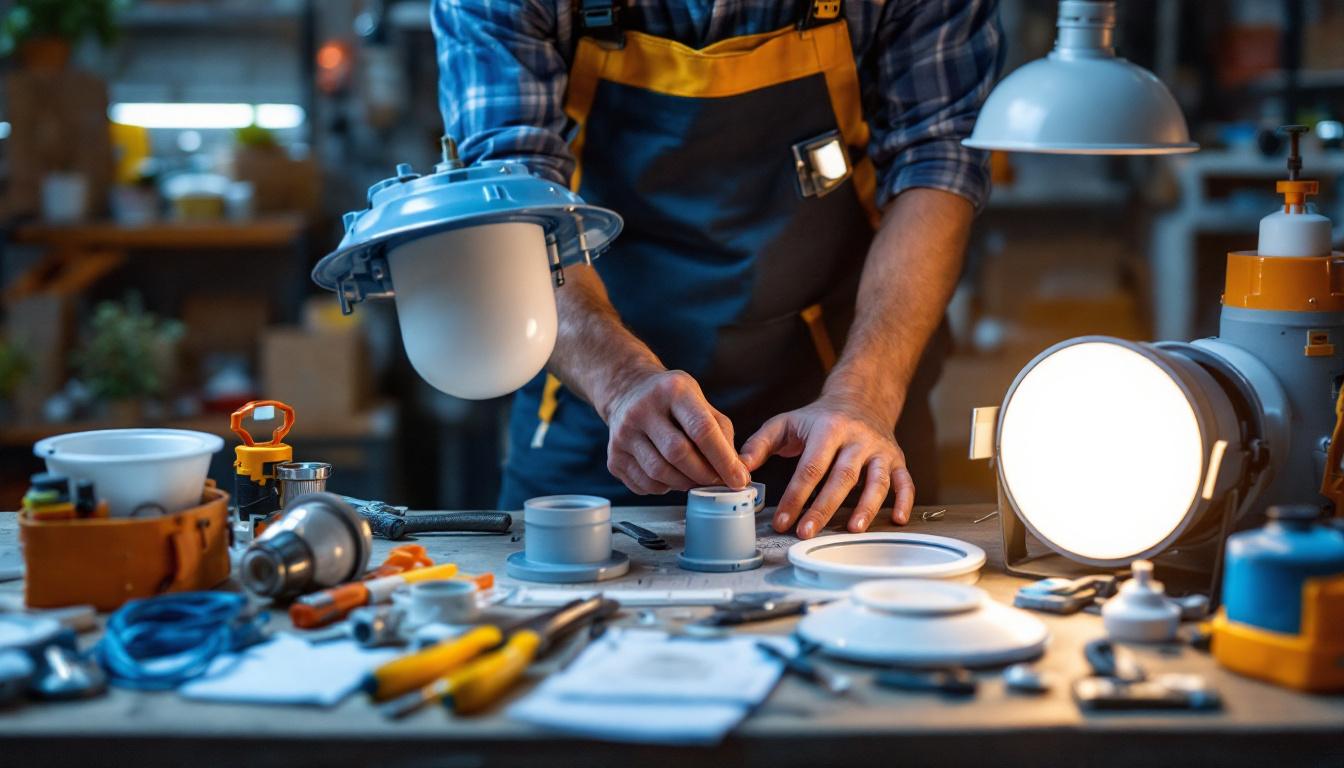
In the world of lighting design and installation, understanding the various components of ceiling lamps is crucial for contractors. Each part plays a significant role in the overall functionality, aesthetics, and efficiency of the lighting solution. This article delves into the essential parts of ceiling lamps and why a comprehensive understanding of these elements is vital for lighting contractors.
Ceiling lamps are not merely decorative fixtures; they are complex assemblies that require a deep understanding of their components. From the light source to the mounting hardware, each part contributes to the lamp’s performance and reliability.
The light source is arguably the most critical component of any ceiling lamp. It can range from incandescent bulbs to modern LED options. Each type has its own set of characteristics that affect brightness, energy efficiency, and lifespan. For instance, LED bulbs are known for their longevity and energy savings, making them a popular choice among contractors.
Understanding the differences between these light sources is essential for contractors. Not only does it influence the initial selection of the lamp, but it also impacts the long-term maintenance and operational costs for clients. Choosing the right light source can enhance the overall lighting experience while also aligning with energy efficiency goals. Additionally, advancements in smart lighting technology have introduced options like color-changing LEDs and dimmable features, allowing for greater customization of ambiance in any space.
The fixture body houses the light source and provides the necessary structure for mounting. This part can vary significantly in design, from sleek and modern to ornate and traditional. The choice of fixture body affects not only the aesthetics of the space but also the lamp’s functionality.
Contractors must consider the materials used in the fixture body. Metal, glass, and plastic each have unique properties that can influence durability and maintenance. For instance, metal fixtures may offer a more robust solution but could require more upkeep to prevent rust or tarnishing. In contrast, glass fixtures can provide a more elegant look but might be more prone to breakage. Furthermore, the weight of the fixture body can impact installation; heavier fixtures may require additional support to ensure safety and stability, particularly in residential settings where ceiling integrity is a concern.
The shade or diffuser is crucial for controlling the quality of light emitted from the fixture. It can soften harsh light, reduce glare, and create a more inviting atmosphere. Different materials, such as fabric, glass, or acrylic, can be used for shades, each contributing to the overall light quality and aesthetic appeal.
For lighting contractors, understanding how different shades affect light distribution is key. A well-chosen shade can enhance the lamp’s performance, while a poor choice can lead to uneven lighting and dissatisfaction from clients. Therefore, selecting the right shade is not just about looks; it’s about functionality as well. Additionally, the color and texture of the shade can significantly influence the mood of a room; for example, a frosted glass shade may create a soft, diffused glow, while a clear glass shade can highlight the bulb’s design and brightness, making it a focal point of the decor.
Moreover, the design of the shade can also play a role in the overall theme of the space. A vintage-style lamp with an intricate stained glass shade can evoke a sense of nostalgia, while a minimalist shade in a monochromatic color can enhance a contemporary aesthetic. This interplay between shade design and interior decor is an important consideration for contractors aiming to provide a cohesive look that resonates with their clients’ tastes and preferences.
Beyond the visible parts of a ceiling lamp, the electrical components are equally important. These elements ensure that the lamp operates safely and efficiently. An understanding of these components is essential for lighting contractors to ensure compliance with safety standards and client satisfaction.
The wiring within a ceiling lamp connects the light source to the power supply. Proper wiring is critical for safety and performance. Contractors must be familiar with the different types of wiring, including their ratings and compatibility with various light sources.
Moreover, understanding the connections is essential for troubleshooting and maintenance. Loose or faulty connections can lead to flickering lights or complete failures, which can be frustrating for clients. A thorough grasp of wiring and connections can help contractors avoid these issues and provide reliable service.
For certain types of lighting, such as fluorescent or low-voltage systems, ballasts and transformers are necessary components. Ballasts regulate the current to the light source, while transformers convert voltage levels to ensure compatibility with the lamp. Understanding these components is vital for contractors to ensure that the lighting system operates efficiently and safely.
Contractors should also be aware of the different types of ballasts available, including magnetic and electronic options. Each type has its pros and cons, and the choice can significantly impact the performance of the lighting system. A well-informed contractor can recommend the best option based on the specific needs of the project.
Proper installation is a cornerstone of successful lighting projects. The mounting hardware used in ceiling lamps plays a critical role in ensuring that fixtures are securely attached and function as intended. Understanding the various mounting options is essential for contractors to provide a safe and effective installation.
The mounting bracket serves as the foundation for the ceiling lamp, providing stability and support. Different types of brackets are available, depending on the weight and design of the fixture. Contractors must select the appropriate bracket to ensure that the lamp is securely mounted, especially in high-traffic areas.
Additionally, the installation process can vary based on the type of bracket used. Familiarity with the installation requirements for each type of bracket can save time and reduce the risk of errors during the installation process.
The canopy is the decorative cover that conceals the mounting hardware and electrical connections. While it may seem like a minor detail, the canopy plays a significant role in the overall appearance of the fixture. Choosing the right canopy can enhance the aesthetic appeal of the lamp and contribute to a polished look in the space.
Contractors should also consider the size and shape of the canopy in relation to the fixture and the ceiling. A well-proportioned canopy can create a harmonious appearance, while a poorly chosen one can detract from the overall design.
For lighting contractors, the quality of the components used in ceiling lamps can significantly impact the overall success of a project. High-quality parts not only enhance the performance of the lighting system but also contribute to the longevity and reliability of the installation.
Investing in quality components can lead to longer-lasting installations. Ceiling lamps constructed from durable materials are less likely to suffer from wear and tear, reducing the need for frequent replacements or repairs. This not only saves time and money for contractors but also enhances client satisfaction.
Moreover, clients are often willing to pay a premium for fixtures that promise longevity and reliability. By using high-quality components, contractors can position themselves as trusted professionals who prioritize quality and performance.
Quality components also play a crucial role in energy efficiency. For instance, using high-performance LED bulbs and efficient ballasts can significantly reduce energy consumption. This not only benefits the environment but also leads to lower utility bills for clients.
In an era where energy efficiency is a top priority for many homeowners and businesses, contractors who prioritize quality components can differentiate themselves in a competitive market. Educating clients about the benefits of energy-efficient lighting can also enhance the contractor-client relationship.
The lighting industry is constantly evolving, with new technologies and trends emerging regularly. For lighting contractors, staying informed about the latest developments in ceiling lamp components is essential for maintaining a competitive edge.
Participating in workshops, seminars, and training sessions can provide valuable insights into the latest advancements in lighting technology. Many manufacturers offer educational resources that can help contractors stay updated on new products and installation techniques.
Additionally, networking with other professionals in the industry can facilitate the exchange of ideas and best practices. By staying engaged with the broader lighting community, contractors can enhance their knowledge and skills, ultimately benefiting their clients.
Every client has unique needs and preferences when it comes to lighting solutions. Understanding the various components of ceiling lamps allows contractors to tailor their recommendations to meet specific requirements. Whether it’s selecting the right light source for a cozy atmosphere or choosing a durable fixture for a commercial space, adaptability is key.
Moreover, being knowledgeable about the latest trends can help contractors offer innovative solutions that resonate with clients. By demonstrating a commitment to quality and adaptability, contractors can build lasting relationships with their clients and enhance their reputation in the industry.
In summary, a deep understanding of ceiling lamp parts is essential for lighting contractors. Each component, from the light source to the mounting hardware, plays a vital role in the functionality, aesthetics, and efficiency of the lighting solution. By prioritizing quality components and staying informed about industry trends, contractors can enhance their service offerings and build strong relationships with clients.
Ultimately, the knowledge of ceiling lamp parts not only empowers contractors to make informed decisions but also positions them as trusted experts in the field. As the lighting industry continues to evolve, embracing this knowledge will be key to success in delivering exceptional lighting solutions.
Ready to elevate your lighting projects with the finest components on the market? Look no further than LumenWholesale, where we provide lighting contractors with spec-grade, high-quality lighting products at unbeatable wholesale prices. Our commitment to cutting out the middleman means you get the best value without the extra cost. With our extensive selection that meets rigorous industry standards, you can trust that your installations will shine with reliability and performance. Plus, with free shipping on bulk orders, you’ll save even more while getting the premium lighting your projects deserve. Don’t compromise on quality or price. Discover wholesale lighting at the best value today and light up your client’s spaces with confidence and style.

Discover how the 10 ft light bar is revolutionizing the lighting industry for contractors.

Discover the transformative benefits of surface mount ceiling lights in your lighting installation projects.

Discover why LED landscape lighting is revolutionizing the work of lighting contractors.

Discover the transformative impact of strategic lighting for cathedral ceilings.